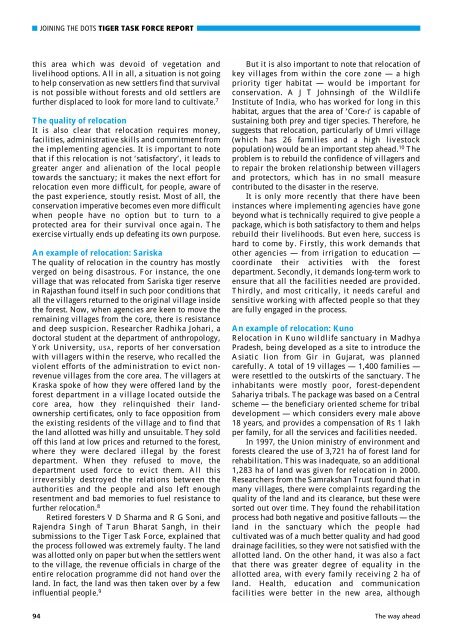Report of the Tiger Task Force - PRS
Report of the Tiger Task Force - PRS
Report of the Tiger Task Force - PRS
Create successful ePaper yourself
Turn your PDF publications into a flip-book with our unique Google optimized e-Paper software.
■ JOINING THE DOTS TIGER TASK FORCE REPORTthis area which was devoid <strong>of</strong> vegetation andlivelihood options. All in all, a situation is not goingto help conservation as new settlers find that survivalis not possible without forests and old settlers arefur<strong>the</strong>r displaced to look for more land to cultivate. 7The quality <strong>of</strong> relocationIt is also clear that relocation requires money,facilities, administrative skills and commitment from<strong>the</strong> implementing agencies. It is important to notethat if this relocation is not ‘satisfactory’, it leads togreater anger and alienation <strong>of</strong> <strong>the</strong> local peopletowards <strong>the</strong> sanctuary; it makes <strong>the</strong> next effort forrelocation even more difficult, for people, aware <strong>of</strong><strong>the</strong> past experience, stoutly resist. Most <strong>of</strong> all, <strong>the</strong>conservation imperative becomes even more difficultwhen people have no option but to turn to aprotected area for <strong>the</strong>ir survival once again. Theexercise virtually ends up defeating its own purpose.An example <strong>of</strong> relocation: SariskaThe quality <strong>of</strong> relocation in <strong>the</strong> country has mostlyverged on being disastrous. For instance, <strong>the</strong> onevillage that was relocated from Sariska tiger reservein Rajasthan found itself in such poor conditions thatall <strong>the</strong> villagers returned to <strong>the</strong> original village inside<strong>the</strong> forest. Now, when agencies are keen to move <strong>the</strong>remaining villages from <strong>the</strong> core, <strong>the</strong>re is resistanceand deep suspicion. Researcher Radhika Johari, adoctoral student at <strong>the</strong> department <strong>of</strong> anthropology,York University, USA, reports <strong>of</strong> her conversationwith villagers within <strong>the</strong> reserve, who recalled <strong>the</strong>violent efforts <strong>of</strong> <strong>the</strong> administration to evict nonrevenuevillages from <strong>the</strong> core area. The villagers atKraska spoke <strong>of</strong> how <strong>the</strong>y were <strong>of</strong>fered land by <strong>the</strong>forest department in a village located outside <strong>the</strong>core area, how <strong>the</strong>y relinquished <strong>the</strong>ir landownershipcertificates, only to face opposition from<strong>the</strong> existing residents <strong>of</strong> <strong>the</strong> village and to find that<strong>the</strong> land allotted was hilly and unsuitable. They sold<strong>of</strong>f this land at low prices and returned to <strong>the</strong> forest,where <strong>the</strong>y were declared illegal by <strong>the</strong> forestdepartment. When <strong>the</strong>y refused to move, <strong>the</strong>department used force to evict <strong>the</strong>m. All thisirreversibly destroyed <strong>the</strong> relations between <strong>the</strong>authorities and <strong>the</strong> people and also left enoughresentment and bad memories to fuel resistance t<strong>of</strong>ur<strong>the</strong>r relocation. 8Retired foresters V D Sharma and R G Soni, andRajendra Singh <strong>of</strong> Tarun Bharat Sangh, in <strong>the</strong>irsubmissions to <strong>the</strong> <strong>Tiger</strong> <strong>Task</strong> <strong>Force</strong>, explained that<strong>the</strong> process followed was extremely faulty. The landwas allotted only on paper but when <strong>the</strong> settlers wentto <strong>the</strong> village, <strong>the</strong> revenue <strong>of</strong>ficials in charge <strong>of</strong> <strong>the</strong>entire relocation programme did not hand over <strong>the</strong>land. In fact, <strong>the</strong> land was <strong>the</strong>n taken over by a fewinfluential people. 9But it is also important to note that relocation <strong>of</strong>key villages from within <strong>the</strong> core zone — a highpriority tiger habitat — would be important forconservation. A J T Johnsingh <strong>of</strong> <strong>the</strong> WildlifeInstitute <strong>of</strong> India, who has worked for long in thishabitat, argues that <strong>the</strong> area <strong>of</strong> ‘Core-I’ is capable <strong>of</strong>sustaining both prey and tiger species. Therefore, hesuggests that relocation, particularly <strong>of</strong> Umri village(which has 26 families and a high livestockpopulation) would be an important step ahead. 10 Theproblem is to rebuild <strong>the</strong> confidence <strong>of</strong> villagers andto repair <strong>the</strong> broken relationship between villagersand protectors, which has in no small measurecontributed to <strong>the</strong> disaster in <strong>the</strong> reserve.It is only more recently that <strong>the</strong>re have beeninstances where implementing agencies have gonebeyond what is technically required to give people apackage, which is both satisfactory to <strong>the</strong>m and helpsrebuild <strong>the</strong>ir livelihoods. But even here, success ishard to come by. Firstly, this work demands thato<strong>the</strong>r agencies — from irrigation to education —coordinate <strong>the</strong>ir activities with <strong>the</strong> forestdepartment. Secondly, it demands long-term work toensure that all <strong>the</strong> facilities needed are provided.Thirdly, and most critically, it needs careful andsensitive working with affected people so that <strong>the</strong>yare fully engaged in <strong>the</strong> process.An example <strong>of</strong> relocation: KunoRelocation in Kuno wildlife sanctuary in MadhyaPradesh, being developed as a site to introduce <strong>the</strong>Asiatic lion from Gir in Gujarat, was plannedcarefully. A total <strong>of</strong> 19 villages — 1,400 families —were resettled to <strong>the</strong> outskirts <strong>of</strong> <strong>the</strong> sanctuary. Theinhabitants were mostly poor, forest-dependentSahariya tribals. The package was based on a Centralscheme — <strong>the</strong> beneficiary oriented scheme for tribaldevelopment — which considers every male above18 years, and provides a compensation <strong>of</strong> Rs 1 lakhper family, for all <strong>the</strong> services and facilities needed.In 1997, <strong>the</strong> Union ministry <strong>of</strong> environment andforests cleared <strong>the</strong> use <strong>of</strong> 3,721 ha <strong>of</strong> forest land forrehabilitation. This was inadequate, so an additional1,283 ha <strong>of</strong> land was given for relocation in 2000.Researchers from <strong>the</strong> Samrakshan Trust found that inmany villages, <strong>the</strong>re were complaints regarding <strong>the</strong>quality <strong>of</strong> <strong>the</strong> land and its clearance, but <strong>the</strong>se weresorted out over time. They found <strong>the</strong> rehabilitationprocess had both negative and positive fallouts — <strong>the</strong>land in <strong>the</strong> sanctuary which <strong>the</strong> people hadcultivated was <strong>of</strong> a much better quality and had gooddrainage facilities, so <strong>the</strong>y were not satisfied with <strong>the</strong>allotted land. On <strong>the</strong> o<strong>the</strong>r hand, it was also a factthat <strong>the</strong>re was greater degree <strong>of</strong> equality in <strong>the</strong>allotted area, with every family receiving 2 ha <strong>of</strong>land. Health, education and communicationfacilities were better in <strong>the</strong> new area, although94 The way ahead
















